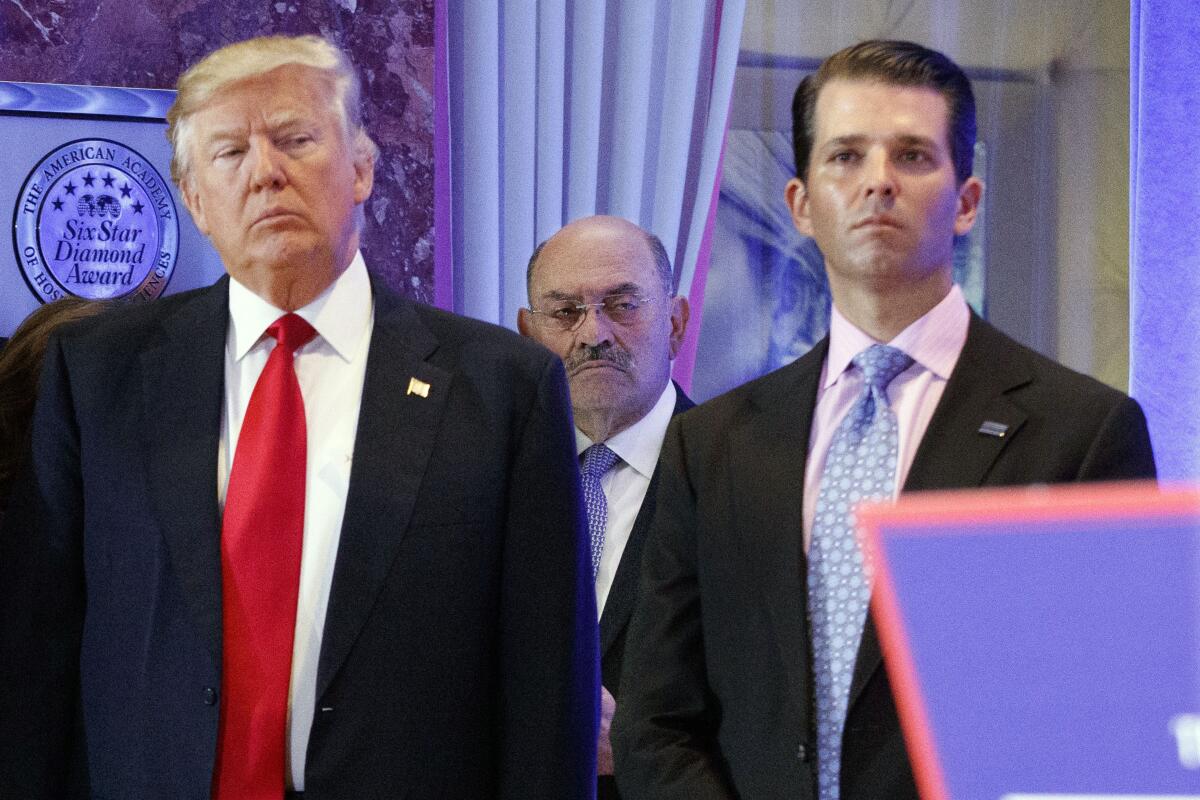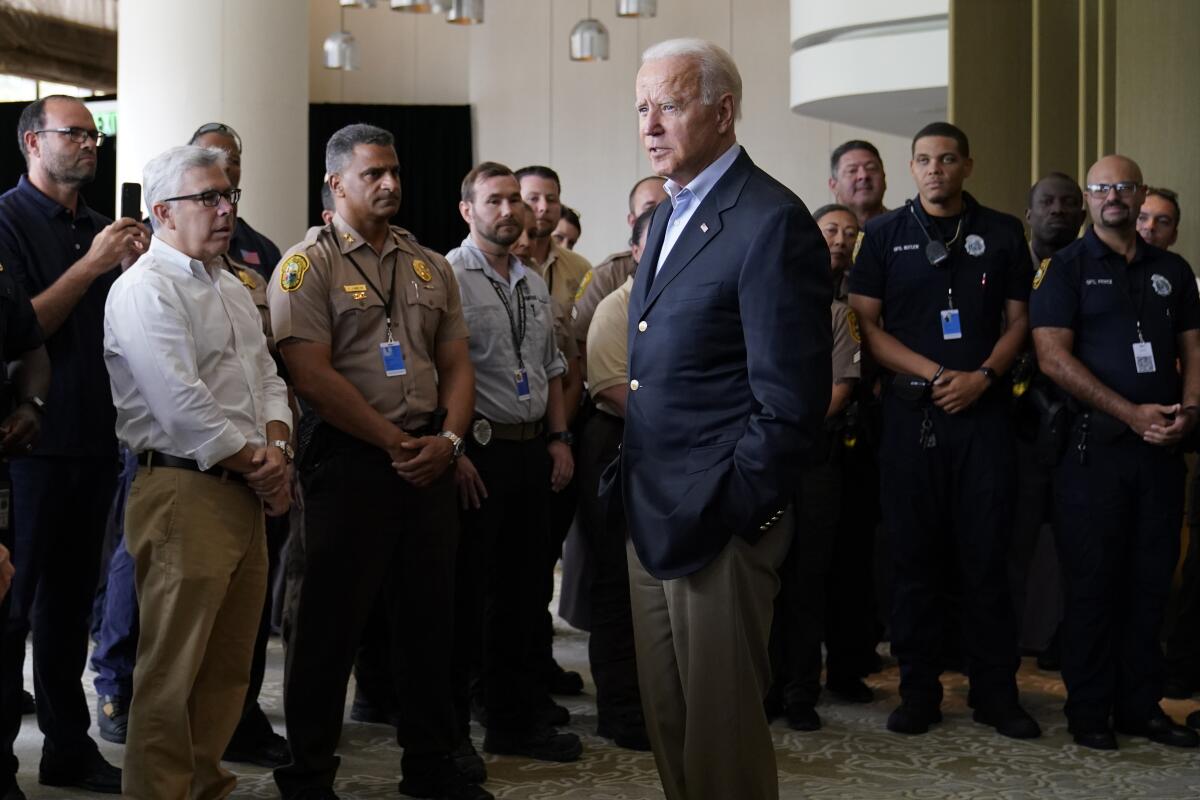Biden can’t avoid a precarious balancing act. His voter base requires it

- Share via
WASHINGTON — This is the July 2, 2021, edition of the Essential Politics newsletter. Like what you’re reading? Sign up to get it in your inbox three times a week.
The past week of posturing over the infrastructure deal that the White House negotiated with a bipartisan group of senators illustrates the difficult balancing act that has defined President Biden‘s tenure: Placate centrists and risk alienating progressives; nod to the left and risk attack from Republicans.
So far, Biden has navigated the tightrope more successfully than a lot of people expected. Despite an evenly divided Senate, a paper-thin majority in the House and a divided Democratic caucus, there’s a good chance that sometime this fall, he’ll win passage of roughly $1 trillion to fix the nation’s roads, bridges, water pipes and other infrastructure as well as an even larger plan to expand support for families with children, widen availability of healthcare, combat climate change and raise taxes on large corporations and the wealthiest Americans.
But as new data on last year’s presidential election show, the balancing act isn’t likely to go away — it’s built into the voter coalition that elected Biden president last year.
Get our L.A. Times Politics newsletter
The latest news, analysis and insights from our politics team.
You may occasionally receive promotional content from the Los Angeles Times.
Biden’s victory required overwhelming support from Black voters — he won their backing 92% to 8%, according to the new numbers from the Pew Research Center. He also did even better than the party’s 2016 nominee, Hillary Clinton, among voters on the left, winning 98% of those who identify themselves as liberal Democrats. And he solidified his party’s support among voters in the millennial generation and Generation Z, who together gave 58% of their votes to Biden — a potentially crucial base for Democrats in the future as the Baby Boomers and older generations decline as a share of the electorate.
But alone, those gains would not have sufficed because former President Trump pushed up his vote among his core supporters to levels many Democrats did not think possible and was able to gain support from Latino voters.
Stronger showing among white men
To gain his victory, Biden outperformed Clinton among groups to the right of the average Democratic activist. He gained significant ground among white men, including some gains among the blue-collar white men who form the strongest part of Trump’s support. He also won 54% of suburban voters, a 9-point improvement over Clinton, and took a solid majority of independents, a group that split down the middle in 2016, Pew’s numbers show.
Those new numbers provide the latest in a growing mass of data that can help us understand why the last election turned out the way it did.
In the hours immediately after an election, exit polls provide information about which groups voted for which candidate. They’re fast and provide important information that helps the television networks make accurate calls on election night. But they have serious shortcomings, including a well-documented tendency to over-count college-educated voters.
Years ago, the exit polls were virtually the only game in town. Now, however, the sources of data have expanded. In April, the Census released its data on who voted, although it does not ask which candidate a person favored. There are also academic studies such as the Cooperative Congressional Election Study and the long-running American National Election Study from the University of Michigan and work from partisan groups like the Democratic firm Catalist, which issued an important analysis of election data in May.
Pew’s analysis of 2020 began with an online survey of 11,818 U.S. adults conducted in November. In the months since, Pew researchers carefully matched the people in that survey with the lists of who voted that each state publicly provides once the election is over. The matching yielded 9,668 people who are known to have voted — “validated voters,” as pollsters refer to them.
Because Pew did similar validated voter studies in 2016 and 2018, they can compare the three elections to see what has changed over time.
In this election, which set turnout records, Trump and Biden each held onto the vast majority of the voters who sided with their party in 2016, Pew and the other analyses have found. That underscores a basic fact of current politics: Whatever divisions exist within each party, they’re dwarfed by the widening gulf between the parties.
Party switchers exist, but not in great numbers. What is more numerous are sporadic voters. About 1 in 4 of the people who voted in 2020 had not voted four years ago, either because they were too young or because they weren’t motivated. The two candidates pulled very different types of new voters to the polls, the Pew survey found.
With the notable exception of Latinos, Trump’s new voters largely reinforced his existing areas of strength. For example, he managed to squeeze out even more white, evangelical Protestants than he had in 2016 — boosting his vote among them from 77% against Clinton to 84% in 2020, Pew’s numbers show. White evangelicals make up just under 1 in 5 voters overall, but were more than one-third of Trump’s voters.
Another, perhaps related, area where Trump gained ground was among white women who did not graduate from college. In 2016, Trump beat Clinton 56% to 33% among them. Last year, Trump pushed his vote among that group to 64%. Biden got 35%, roughly the same as Clinton. Both candidates were able to gain because third-party voting, which was unusually high in 2016, declined sharply in 2020.
And, as previously noted, Trump did better in 2020 among Latino voters, especially those without college degrees. Some Republican strategists see that as an indicator that Latino voters in this decade are following the same path that white voters took earlier — with the college-educated moving to the Democrats and non-college voters to the GOP. One election doesn’t prove a trend, but at minimum, last year’s results put both parties on notice that many Latino voters are up for grabs.
In 2020, Biden countered Trump’s gains by outperforming Clinton among men, especially white men, as well as suburbanites and independents.
Biden significantly narrowed Trump’s margin among married men, a group that has given strong support to Republicans for years. In 2016, Trump won that group by 30 points. In 2020, Biden cut down that edge, with Trump winning the group 54% to 44%.
Among white men, Biden gained across the board. White men with a college education were a Republican mainstay into the 1990s. By 2016, enough had moved to the Democrats to make an almost even split. Last year, they went for Biden by 10 points in Pew’s data.
Biden also managed to improve over Clinton among white men without a college degree, Pew found. Those blue-collar white voters remained Trump’s strongest group — he won 66% of their votes in 2020, but that was down from the 73% he got against Clinton. Biden won 31% — not a lot by any means, but enough to make the difference between defeat and victory in northern industrial swing states like Wisconsin and Pennsylvania.
Biden traveled to Wisconsin this week, campaigning for his legislative priorities, especially the infrastructure package. It’s no accident that he and his aides stress constantly that most of the jobs the legislation is projected to generate would not require a college degree.
Some progressive Democrats consider that deal inadequate. They’ve pushed for Biden to go further. The president agrees with the progressives on the merits on several issues, and for Democrats to hold their own in coming elections, he needs to keep progressives motivated.
At the same time, as the two parties ready their campaigns for the midterm, both will devote huge resources to sway the loyalties of suburbanites and independents, many of whom are more skeptical of big federal spending programs and worried about potential inflation, as recent polls have shown.
Facing such conflicting preferences from key parts of his coalition, Biden won’t be able to retire the balancing act anytime soon.
Trump’s company, and accountant, indicted
Allen Weisselberg, Trump’s longtime accountant, surrendered to New York prosecutors Thursday morning, several hours before the New York District Attorney’s office unveiled an indictment in its years-long investigation of Trump’s company, Chris Megerian and Janet Hook reported.

The indictment charges the company with having engaged in “a 15-year-long tax fraud scheme” in which it provided Weisselberg with $1.7 million worth of benefits that were not reported as income, Carey Dunne, an assistant district attorney, said in the courtroom Thursday. A spokesperson for the district attorney described the indictment as part of an “active, ongoing investigation.” Further indictments could come later this year before Dist. Atty. Cyrus Vance leaves office, although the charges are a clear indication that prosecutors have not succeeded in getting Weisselberg to testify against Trump.
The Trump Organization issued a statement criticizing the decision to bring criminal charges, saying “this is not justice; this is politics.”
What could happen to Trump’s company as the result of an indictment? Megerian and Del Wilber looked at the potential impact.
And what do we know about Weisselberg? He has long kept Trump’s secrets.
Recall election date set
The recall election for Gov. Gavin Newsom has been set for Sept. 14, Phil Willon reported. Lt. Gov. Eleni Kounalakis set the date on Thursday, shortly after Secretary of State Shirley Weber certified that a sufficient number of valid recall petitions had been submitted. Candidates will now have just over two weeks to decide whether to jump into the race. A key question will be whether any Democrat decides to run against Newsom, which could undermine his strategy of portraying the recall as strictly a partisan effort by Republicans to overturn the last election.
Supreme Court delivers a blow to voting rights
The Supreme Court ended its term on Thursday with two opinions that split the justices 6-3 along party lines.
As David Savage reported, the justices upheld two Arizona voting restrictions that Democrats had challenged as violations of the Voting Rights Act. The court’s decision, by Justice Samuel A. Alito Jr., greatly limited the reach of a key section of the law. Alito’s opinion conceded that the two rules might have a greater impact on Native Americans and Latinos than on white voters, but said because the disparity was small and not the result of intentional discrimination, the law did not forbid them.
“Mere inconvenience cannot be enough to demonstrate a violation” of the Voting Rights Act, he wrote.
Enjoying this newsletter? Consider subscribing to the Los Angeles Times
Your support helps us deliver the news that matters most. Become a subscriber.
That drew a sharply worded dissent by Justice Elena Kagan. Writing for the court’s three Democratic appointees, Kagan accused the majority of undoing Congress’ intent in passing the voting rights law.
“What is tragic here is that the court has (yet again) rewritten — in order to weaken — a statute that stands as a monument to America’s greatness, and protects against its basest impulses,” she wrote.
In its other decision, by Chief Justice John G. Roberts Jr., the court struck down California’s requirement that charitable groups reveal their donor lists to the state attorney general’s office. The state said the rule was needed to help detect fraud. The court, however, agreed with conservative groups who said the mandatory disclosure violated their rights of free association under the 1st Amendment and could deter people from supporting potentially unpopular causes.
The latest from politics
Boston has a long history of racism. Now, all four of the city’s top mayoral candidates are women of color, Janet Hook reported.
Utah’s Republican Gov. Spencer Cox is part of a rare group in politics these days, Mark Z. Barabak wrote — a politician who doesn’t believe in negative attacks and a Republican who eschews Trump. He admits he’s an outlier, but hopes that eventually the pendulum might swing back toward his brand of more inclusive politics.
Trump visited Texas on Wednesday and criticized Biden’s border policies, Molly Hennessy-Fiske reported. Appearing with Trump, Texas Gov. Greg Abbott pushed for completion of the former president’s border wall, which Biden has halted.
The latest from Washington
The House, with only two Republicans agreeing, voted to create a committee to investigate the Jan. 6 attack on the Capitol, Sarah Wire reported. On Thursday, House Speaker Nancy Pelosi named eight members to serve on the panel, including California Democratic Reps. Adam B. Schiff of Burbank, the chair of the Intelligence Committee; Zoe Lofgren of San Jose, the chair of the House Administration committee, which has oversight of the Capitol Police; and Pete Aguilar of Redlands. She also named one Republican, Rep. Liz Cheney of Wyoming, whose insistence that Trump’s role in the attack should be investigated has made her an outcast in her caucus.
Biden, comforter in chief, traveled to Florida to meet families of those lost in the collapse of the Champlain Towers South condominium building in Surfside, north of Miami Beach. As Eli Stokols and Jenny Jarvie wrote, the visit highlighted Biden’s empathy, a signature trait.

The House on Thursday passed a $715-billion surface transportation bill that will be a key framework for considering Biden’s infrastructure plan. Jennifer Haberkorn looks at some 200 California-related infrastructure projects the bill would fund.
In a meeting with governors and administration officials to discuss the coming fire season, Biden pledged support for firefighters on the front lines in the West, including higher pay, Megerian and Anna Phillips reported.
We’re two Americas, vaccinated and unvaccinated, Doyle McManus wrote. Alabama football could fix that, he suggested.
California representatives helping Big Tech
Some of California’s U.S. House members are taking a rare bipartisan stance — to help Big Tech, Sasha Hupka reported. Lawmakers, including Democratic Reps. Lofgren, whose district covers much of Silicon Valley, Lou Correa of Santa Ana and Eric Swalwell of Dublin, teamed up with Republicans including Tom McClintock of Elk Grove and Darrell Issa of Bonsall to vote against advancing a package of anti-trust bills that passed the Judiciary Committee after lengthy debate.
Other members of California’s huge delegation, including Republican leader Kevin McCarthy of Bakersfield, also say they oppose the bills. So far, Pelosi is one of the few prominent Californians to support the current proposals, which are aimed at curbing the power — and profits — of major tech companies.
Rallying against China
Secretary of State Antony J. Blinken recently wrapped up a trip to Europe that showed significant progress in repairing relations with America’s NATO allies. But as Tracy Wilkinson wrote, Blinken has a tougher task in persuading European countries to join the U.S. in its effort to contain the rising power of China. While German officials agree with the U.S. that China poses a threat to their interests, other European countries are less concerned.
Quick programming note: Essential Politics will be off Monday. The newsletter will be back in your inbox on Wednesday, July 7.
Stay in touch
Keep up with breaking news on our Politics page. And are you following us on Twitter at @latimespolitics?
Did someone forward you this? Sign up here to get Essential Politics in your inbox.
Until next time, send your comments, suggestions and news tips to politics@latimes.com.
Get the L.A. Times Politics newsletter
Deeply reported insights into legislation, politics and policy from Sacramento, Washington and beyond. In your inbox twice per week.
You may occasionally receive promotional content from the Los Angeles Times.




